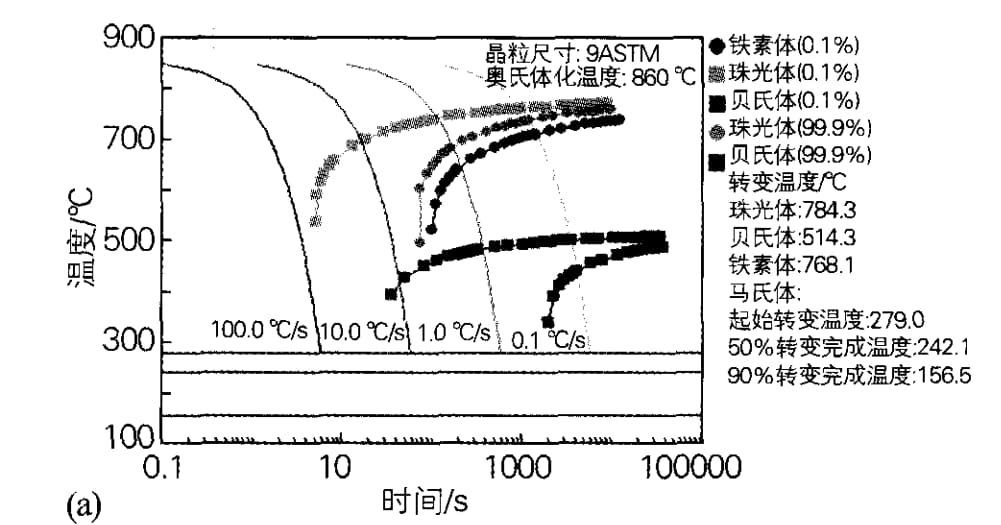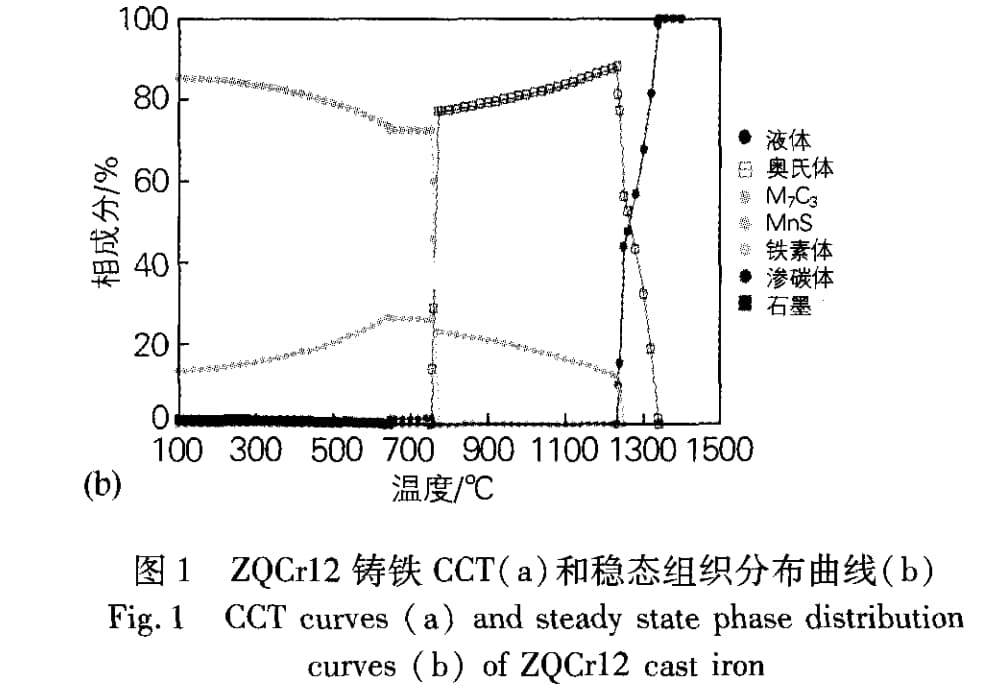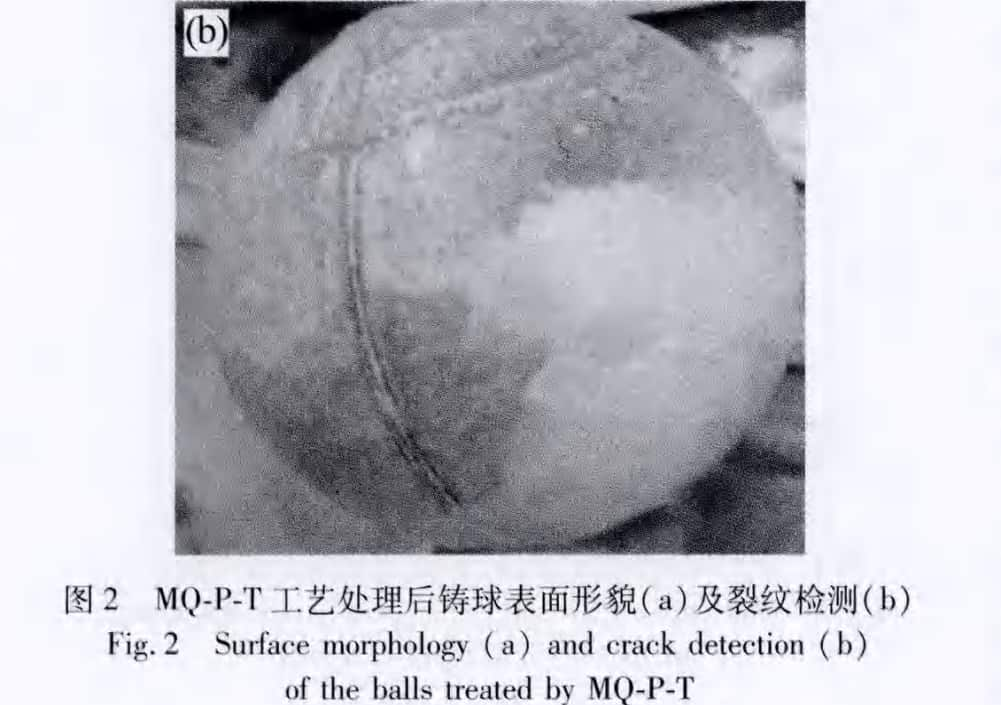Application of new MQ-P-T technology in white cast iron grinding balls (2)
1.Test material and method
The high chromium cast iron products treated in this paper are made of hot metal with a temperature of 1550 °C, which are cast into 80mm diameter high chromium cast iron grinding balls in a cold mould. The chemical composition of the material is shown in Table 1.
In order to analyze the microstructure of the cast ball treated by the MQ-P-T process, the CCT curves of Fe-2.4C-12Cr white cast iron, continuous cooling transformation (CCT-RRB- curves, and the microstructure and proportion curves of the steady-state materials were calculated by Jmatpro software, as shown fig. 1. It can be seen from Fig. 1 that in order to avoid the precipitation of pearlite and ferrite, the residence time of the material in the temperature range of 520-780 °C should be shortened as far as possible, and the cooling rate of the sample should be higher than 1 °C/s. At the same time, because of the high chromium cast, the iron is easy to be quenched and cracked, so it is not suitable to be cooled at too high a continuous cooling rate.
After being treated by the MQ-P-T process, the high chrome cast iron grinding ball was subjected to mechanical and performance measurement: the hardness sample of 10mm x 5mm x 80mm was cut along the radial direction, and 500RA type Lo measured the hardness, and the standard impact sample of 10mm x 10mm x 55mm was cut along the radial direction, the impact test was carried out on the PTM2200-D1 automatic impact test machine. The specimen, microstructure, microstructure, and microstructure were observed with Nikon Eclipse MA200 optical microscope (OM). The scanning (SEM) is carried out on the Jeol Company’s Sirion 200 model equipment; the voltage is selected 10kV. Tem sample in Jeol Jem 2100 transmission, electron microscope, upward, observation, acceleration, voltage selection 200 kV. Using the residual stress testing equipment produced by Jinan Sigma Company, the residual stress on the surface of the cast ball was measured by the blind hole method.
2.Test result and analysis
In the MQ-P-T process, rapid cooling is realized by the leaching solution. Air cooling is used to warm up the effluent; carbon is precipitated and distributed by self-tempering self-tempering is realized. Thus, quenching and distribution, tempering, temperature, and time are controlled by the time of immersion and extraction of the cast ball. Based on 80mm diameter casting, ball, NOR, Oil-Quenching and MQ-P-T, the mechanical properties and microstructure were tested and analyzed. Before the mechanical properties and analysis, the surface cracks were detected by coloring flaw detection. It was found that the surface of the cast ball after MQ-P-T treatment was good, and no cracks were found, as shown in Fig. 2.
2.1 Hardness
As shown in Fig. 3, after MQ-P-T treatment, the average radial hardness of high chromium cast ball is about 60HRC, which is about 17HRC higher than that of air-cooled cast ball and about 4HRC higher than that of oil quenching. After treated by the MQ-P-T process, the variation range of hardness is ± 1 HRC, the variation of air-cooled radial hardness is ± 3 HRC, and the variation of oil-quenched radial hardness is ± 2.6 HRC. The uniformity of hardness of the treated by the MQ-P-T process is the best. The high hardness and the low hardness fluctuation range are very advantageous to improving the material wear resistance. During the MQ-P-T process, the ball is quenched by water and air alternately several times, which can effectively reduce the temperature difference between inside and outside and improve the ball’s hardness and microstructure uniformity. The difference in hardness between inner and outer parts of air-cooled specimens is the most, mainly caused by the great difference of mechanical properties between high-hardness carbide and low-hardness pearlite matrix.
2.2 Impact property
Charpy impact test specimens of 10 mm × 10 mm × 55 mm without slop were cut in the cast ball, and the impact test was carried out at room temperature (25 °C) on the PTM2200-D1 automatic impact testing machine. The specific results are shown in Table 2; after MQ-P-T treatment, the average impact toughness of the cast ball is 12.6 J/cm, which is about 10 J/cm higher than that of air cooling treatment, about 4 times higher than that of air cooling treatment, and about 2 times higher than that of oil quenching treatment. It can be concluded that the high chromium cast ball treated by the MQ-P-T process not only has very high hardness but also has very good impact toughness and is much higher than the conventional heat-treatment process.







